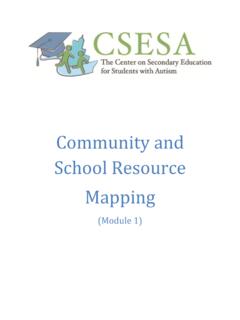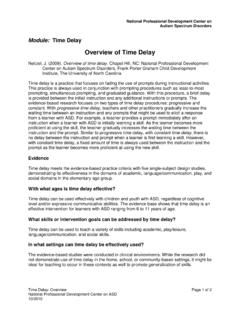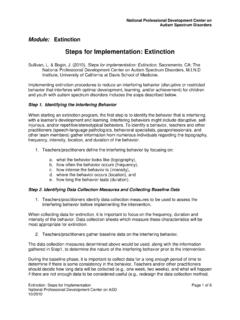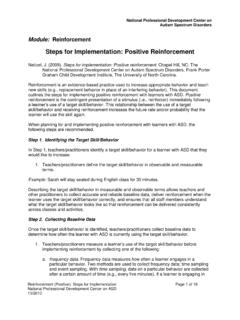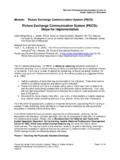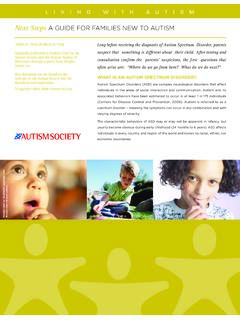Transcription of VISUAL SUPPORTS - csesa.fpg.unc.edu
1 Evidence Based Practice Training VISUAL SUPPORTS Objectives What are evidence-based practices? Identify 27 EBPs for students with ASD VISUAL SUPPORTS Target skills addressed Examples Steps for implementation Keys to effective use Resources to learn more about implementing VISUAL SUPPORTS What are EBPs? Focused interventions that: Produce specific behavioral and developmental outcomes for a child Have been demonstrated as effective in applied research literature Can be successfully implemented in educational settings (Odom, Colett-Klingenberg, Rogers, & Hatton, 2010) Evidence Based Practices (2014) Antecedent-based interventions Cognitive behavioral intervention* Differential reinforcement Discrete trial training Exercise Extinction Functional behavior assessment Functional communication training Modeling Naturalistic interventions Parent-implemented intervention Peer-mediated instruction/intervention Picture exchange communication system Pivotal response training Prompting Reinforcement Response interruption/redirection Scripting Self-management Social narratives Social skills training Structured play groups Task analysis Technology-aided intervention/instruction Time delay Video modeling VISUAL SUPPORTS For All EBPs Choose skill/behavior Collect baseline data Make specific decisions related to EBP Plan Implement steps of EBP well and consistently Implement Collect data on student progress Collect data on your implementation Assess VISUAL SUPPORTS Why use VISUAL SUPPORTS ?
2 When we present information verbally, the words are only available for a brief moment. When we present information visually, it can be there for as long as the individual needs it. Who uses VISUAL SUPPORTS ? Definition of VISUAL SUPPORTS Any tool presented visually that SUPPORTS an individual as he or she moves through the day. Enhances the individual's ability to understand, anticipate, and participate Supplements verbal instruction (National Research Council, 2001) Target Skills Addressed Adaptive behavior skills including: task engagement independent performance transitions across activities increasing response chain length Social initiation and interaction skills Reducing self-injurious behavior Types of VISUAL SUPPORTS pictures Written words Objects within the environment VISUAL boundaries Schedules Maps Labels Organization systems Timelines Scripts Examples of VISUAL SUPPORTS Visually-defined work area Snack choice VISUAL Examples of VISUAL SUPPORTS Class agenda Individual schedule Examples of VISUAL SUPPORTS Individual schedule Examples of VISUAL SUPPORTS Individual schedule Examples of VISUAL SUPPORTS VISUAL labels VISUAL labels Examples of VISUAL SUPPORTS Organizational system - community Organizational system - school Examples of VISUAL SUPPORTS Script When the person taking the order at McDonald's says: "Can I help you?
3 " I say: "I want a Quarter Pounder with cheese only on it." They usually say "Quarter Pounder ,cheese only?" And I say: "Yes, please. The person taking my order usually says: "Do you want fries?" And I say, "Yes, please, medium fries and a medium Sprite to drink. The person behind the counter then asks me if that will be all, and I say: "Yes, thank you. I give the person my money and they give me my change. I take one step to the side at the counter so the person behind me can give their order while I wait for my order to be put on the counter. Examples of VISUAL SUPPORTS Transition support Steps for Implementation Link to EBP Brief for VISUAL SUPPORTS Implementation Checklist for VISUAL SUPPORTS **Scoring Key: 2 = implemented; 1 = partially implemented; 0 = did not implement; NA = not applicable Link to EPB - VISUAL SUPPORTS Collecting Data VISUAL Schedule Week: Monday Tuesday Wednesday Thursday Friday Goal met? 9/1 - - - + - N 9/8 + + - - - N 9/15 + + + + + Y 9/22 Y / N 9/29 Y / N With VISUAL SUPPORTS , Tom will transition between all activities in language arts class with no more than 2 verbal prompts per day across one week of data.
4 Did Tommy transition between all activities in Language Arts class with no more than 2 prompts? (**+ means yes, - means no**) Individualize it to the needs of the student Think of the size and portability of the VISUAL Consider all settings: home, school, work, and the community Attach meaning to the VISUAL support using key words and phrases Stick with it it may take time before you see results The Key to Effective Use of VISUAL SUPPORTS Summary: When individuals with ASD are given the opportunity to learn with VISUAL SUPPORTS or cues they: Complete more tasks by themselves therefore increasing their independence Learn more rapidly Demonstrate decreased levels of frustration, anxiety, and aggression related to task completion Adjust more readily to changes in their environments (Savner & Myles, 2000) To Learn Find additional information on VISUAL SUPPORTS and other Evidence Based Practices within the following resources. Evidence-based Practice Resources EBP literature review EBP Case Studies for High School EBP Briefs ( ) Overview Evidence Base Steps for Implementing Implementation Checklist Sample Data Collection Forms (optional) Autism Internet Modules ( ) EBP Case Studies for High School EBP Literature Review Autism Internet Modules Action Plan What will I do tomorrow: 1.
5 2. 3. Questions



